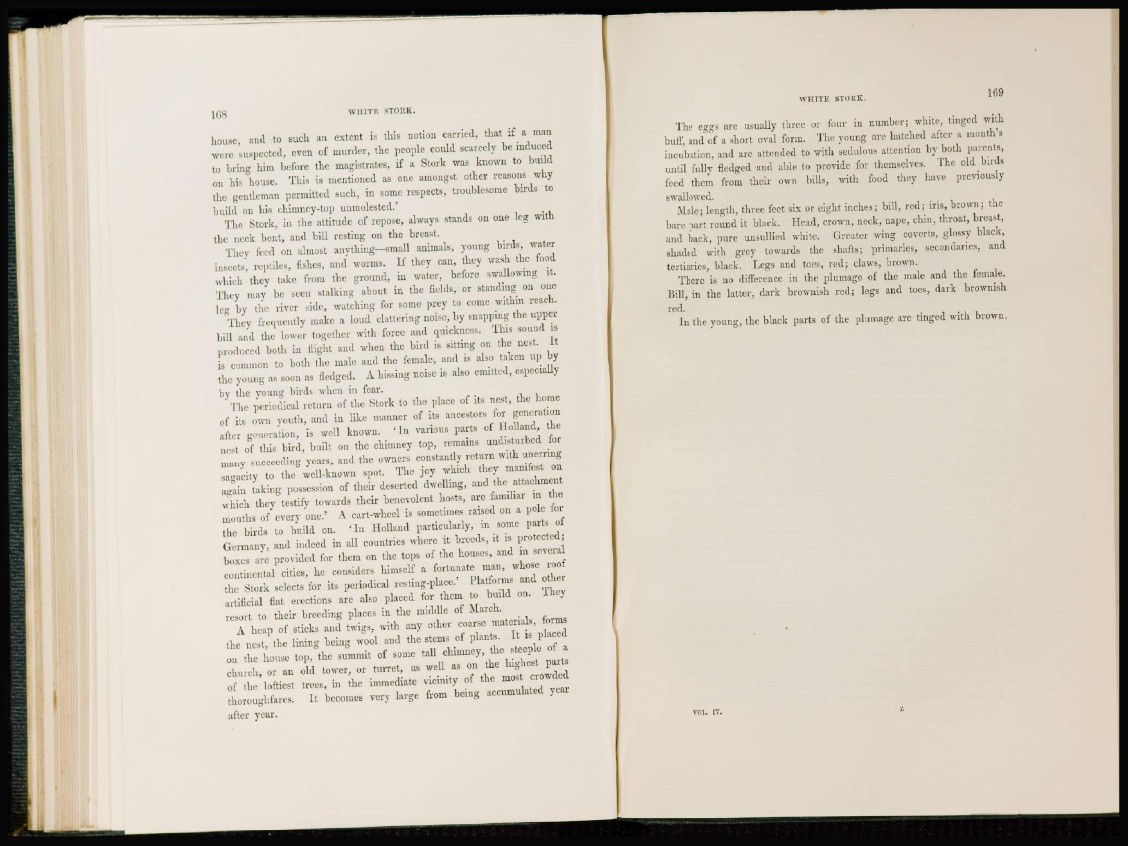
168 WHITE STORK.
house, and to such an extent is this notion carried, that if a man
were suspected, even of murder, the people could scarcely be induced
to bring him before the magistrates, if a Stork was known to build
on his house. This is mentioned as one amongst other reasons why
the gentleman permitted such, in some respects, troublesome birds to
build on liis chimney-top unmolested.'
The Stork, in the attitude of repose, always stands on one leg with
the neck bent, and bill resting on the breast.
They feed on almost anything—small animals, young birds, water
insects, reptiles, fishes, and worms. If they can, they wash the food
which they take from the ground, in water, before swallowing it.
They may be seen stalking about in the fields, or standing on one
leg by the river side, watching for some prey to come within reach.
They frequently make a loud clattering noise, by snapping the upper
bill and the lower together with force and quickness. This sound is
produced both in flight and when the bird is sitting on the nest. It
is common to both tin' male and the female, and is also taken up by
the young as soon as fledged. A hissing noise is also emitted, especially
by the young birds when in fear.
The periodical return of the Stork to the place of its nest, the home
of its own youth, and in like manner of its ancestors for generation
after generation, is well known. 'In various parts of Holland, the
nest of this bird, built on the chimney top, remains undisturbed for
many succeeding years, and the owners constantly return with unerring
sagacity to the well-known spot. The joy which they manifest on
again taking possession of their deserted dwelling, and the attachment
which they testify towards their benevolent hosts, arc familiar in the
mouths of every one.' A cart-wheel is sometimes raised on a pole for
the birds to build on. ' I n Holland particularly, in some parts of
Germany, and indeed in all countries where it breeds, it is protected;
boxes arc provided for them on the tops of the houses, and in several
continental cities, he considers himself a fortunate man, whose roof
the Stork selects for its periodical resting-place.' Platforms and other
artificial fiat erections are also placed for them to build on. They
resort to their breeding places in the middle of March.
A heap of sticks and twigs, with any other coarse materials, forms
the nest, the lining being wool and the stems of plants. It is placed
on the house top, the summit of some tall chimney, the steeple of a
church, or an old tower, or turret, as well as on the highest parts
of the loftiest trees, in the immediate vicinity of the most crowded
thoroughfares. It becomes very large from being accumulated year
after year.
The eggs are usually three or four in number; white, tinged with
buff, and of a short oval form. The young are hatched after a month's
incubation, and are attended to with sedulous attention by both parents,
until fully fledged and able to provide for themselves. The old birds
feed them from their own bills, with food they have previously
swallowed.
Male; length, three feet six or eight inches; bill, red; iris, brown; the
bare part round it black. Head, crown, neck, nape, chin, throat, breast,
and back, pure unsullied white. Greater wing coverts, glossy black,
shaded with grey towards the shafts; primaries, secondaries, and
tcrtiaries, black. Legs and toes, red; claws, brown.
There is no difference in the plumage of the male and the female.
Bill, in the latter, dark brownish red; legs and toes, dark brownish
red.
I n the young, the black parts of the plumage are tinged with brown.